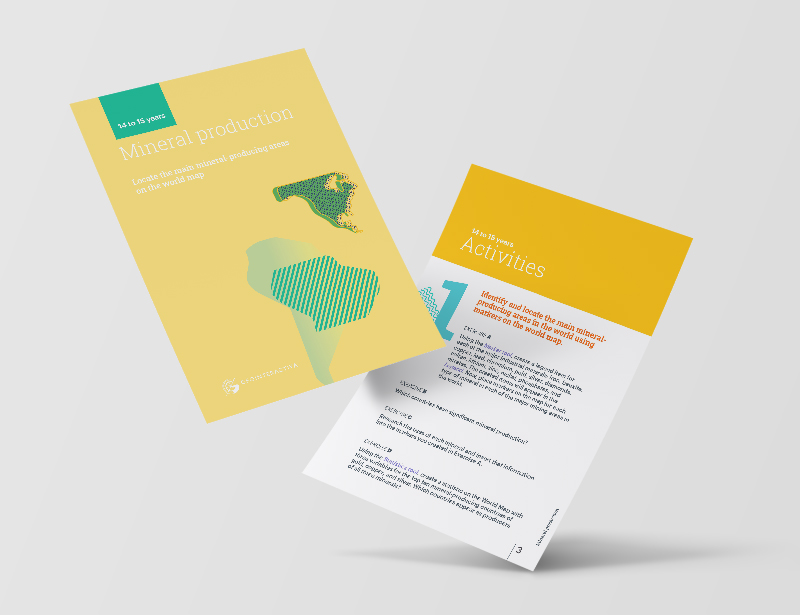
secondary (14-15 years old).
Mineral production
In this activity, you will discover the importance of the distribution of natural resources on the planet, especially the location of the main mineral production zones worldwide. It’s an important topic that will help you understand the significance of these resources for the global economy and the development of societies.
In this downloadable resource, you will find a PDF with instructions to liven up your classes. On one hand, we’ll show you which platform tool you’ll be working with, and on the other hand, we’ll suggest activities suitable for 14-15-year-old students.
Do you want your classes to be stimulating? Start today with GeoInteractive.
we suggest teaching geography in a fun way
What will your students learn from this educational activity?
Geography is a discipline that deals with the study of the Earth’s surface and the interactions between human societies and their environment. One of the most important topics in geography is the distribution of natural resources on the planet. In this regard, the location of the main mineral production zones in the world is a relevant topic that helps understand the significance of these resources for the global economy and the development of societies.
Part 1: Introduction
Minerals are inorganic substances found in the Earth’s crust that are of great importance for modern industry and technology. The most commonly used minerals include iron, copper, gold, silver, zinc, lead, and aluminum. These minerals are found in different parts of the world, and their extraction and production have a significant impact on the economy and development of countries.
This article presents a possible exercise for high school students on the importance of identifying the major mineral-producing regions in the world. The objective of this exercise is to help students understand the geographical distribution of mineral resources and their impact on the global economy.
Part 2: Identifying the major mineral-producing regions in the world
The first step of the exercise is to identify the major mineral-producing regions in the world. Students can use different sources of information, such as geography books, maps, specialized websites, etc. It is important for students to identify at least three mineral-producing regions and indicate the mineral extracted and the country or countries where it is found for each one.
For example, a possible mineral-producing region is the Chilean Copper Belt, which is the world’s largest source of copper. Another example is the Witwatersrand Basin in South Africa, which is the world’s largest gold-producing region. The Ruhr Basin in Germany, which is Europe’s largest coal-producing region, can also be mentioned.
Part 3: Analyzing the importance of mineral-producing regions
Once students have identified the major mineral-producing regions, they can be asked to analyze their importance for the global economy and the development of countries. To do so, students can perform the following activities:
Research how much of a specific mineral’s worldwide production is produced in the region they have identified. Indicate how many countries import that mineral from the identified production region and in what proportion. Research which countries are the main consumers of that mineral and how production in the identified region affects the global market for that mineral. Analyze the social, economic, and environmental consequences of mineral extraction in the identified region.
Part 4: Renewable energies and their relation to minerals
Minerals are not the only natural resources that are important for the global economy. In recent years, renewable energies have become a topic of great importance due to their potential to reduce greenhouse gas emissions and mitigate climate change. However, the technologies used to generate renewable energies depend largely on minerals.
For example, solar panels use silicon for the production of solar energy, while wind turbines require metals such as copper and iron for their manufacture. Therefore, it is important for students to understand the relationship between minerals and renewable energies and how their production and distribution can have an impact on the transition to a more sustainable energy model.
Part 5: Conclusions
In conclusion, the proposed exercise allows students to understand the importance of locating the main mineral production zones in the world and their impact on the global economy and the development of countries. Additionally, this exercise enables students to understand the relationship between minerals and renewable energies, which is fundamental for comprehending the challenges and opportunities that exist on the path towards a more sustainable energy model.